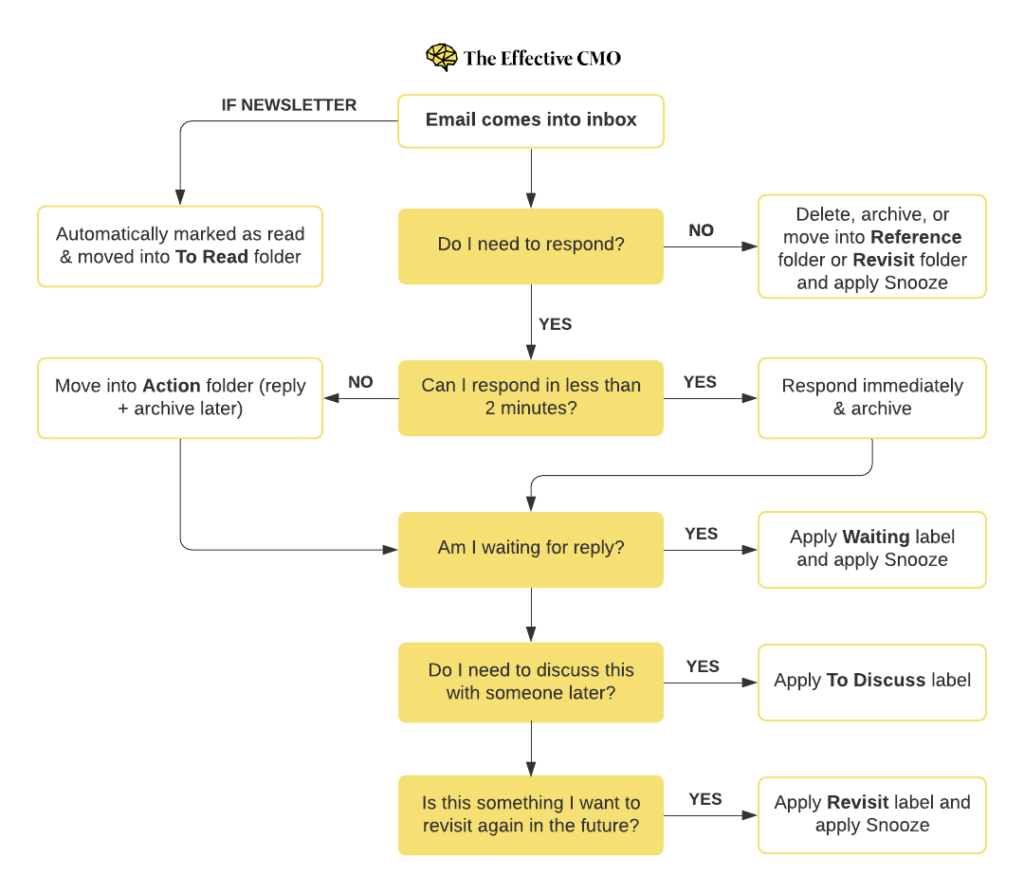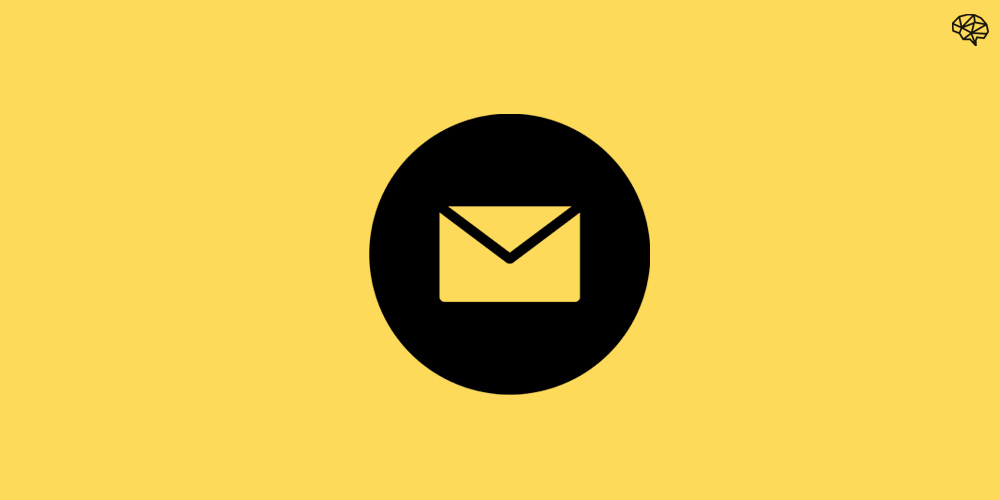If you’re reading this, email is very likely a (big) part of your life.
You probably spend a good chunk of time sending & responding to emails every single day and I’m willing to bet your inbox is a semi-organized mess at best. Or at least that’s what I’ve seen from most people I’ve worked with.
As a CMO, I receive anywhere from 30 to 50 emails per day. Sometimes more. It’s the communication channel I use with my internal team and our numerous external partners to stay on top of everything that’s going on.
But as good as email is for asynchronous communication, it can be a major distraction if not managed the right way. It can very easily take you away from the actual important work you need to do.
What’s more, as your team and organization grow, the email beast grows with it. With a bigger team, more partners, and more opportunities, your inbox grows almost exponentially. Without an effective system to manage it all, it’s all too easy to get overwhelmed.
Over the years, I’ve tinkered with a few different systems for managing my email and staying on top of my inbox. Here is the one that’s worked best for me.
Why Inbox Zero
Here’s what I strive to have my inbox look like at the end of every workday:

We hear a lot about inbox zero (some good, some bad). But inbox zero isn’t the end goal. It’s just the means to ensure nothing important gets missed.
Inbox zero doesn’t mean all emails are read, replied to, or processed at all times. It means every email that comes into my inbox has been either processed OR assigned a next step. For me, inbox zero is the best way to ensure no email gets looked over as it forces me to take some (small) action on every single email.
The ‘Next Step’ Email Inbox System
Here’s a high level view of my system:

As you can see, every email that comes into my inbox (except those I’ve automated) is either archived, deleted, replied to or has been assigned some next step. Nothing is left hanging.
For clarity – my goal with processing email is to get in, process, and get out. This system is what allows me to do that so I can focus on higher impact activities.
Let’s go ahead and break down each step.
Note – I want to give credit to Dan, Thanh, and Andreas whose work inspired the different elements of my email management system.
Step 1 – Process the inbox
When I sit down to ‘process email’, I start with my inbox. If I have new emails sitting in there, I run through those first. I do one of three things:
- Reply to it if it takes less than 2 minutes*
- Delete it or archive it if it doesn’t require further processing
- Move it to a different folder for future processing
*The 2 minute rule comes from David Allen’s book Getting Things Done. It states that if a task can be done in two minutes or less, it’s best to do it immediately.
This processing mechanism allows me to get back to inbox zero very quickly.
Step 2 – Review my Action folder
Once my inbox is cleared out, I’ll begin reviewing my different folders. Here’s the simple folder structure I use in Gmail:

The folder in which I spend the majority of my time is the Action folder. Every email that takes longer than 2-5 minutes to respond to gets moved into this folder during processing (step one).
After I respond to an email in the Action folder, I remove the label and either archive it or move it to another folder (eg. ‘Waiting Reply’ if I’m waiting for a reply and want to follow up on a response or ‘Revisit’ if I want to look at it again in the future).
My goal is to clear out my Action folder each day.
Pro tip – each folder has a number assigned to it to make it easier and faster for me to apply and remove labels. I simply have to type in the number one and it automatically pulls up the ‘Action’ folder as the primary label.
Pro tip – if you want to add a layer of prioritization to your ‘action’ folders, consider using Gmail’s star options. I don’t use them as often as I used to but it’s a great way to identify what emails you want to focus on first.
Pro tip – it’s important to take your energy levels into consideration. Long action emails generally require more time and mental energy so I’ll try to tackle those in my morning admin blocks. Quick action emails are often easier to respond to and so I’ll process those in the afternoons or evenings.
Step 3 – Up for discussion
Folder #2 is To Discuss. This is where I move emails that contain topics, tasks, or projects I want to discuss with one or more members of my team.
When I’m preparing an agenda for my meetings – whether it’s team meetings or direct report meetings – I’ll come to this folder and pull out what I need. Once an item has been discussed, I’ll remove the label (effectively archiving the email in the process).
Step 4 – Waiting on someone
Folder #3 is Waiting Reply and it contains all the emails I’m waiting to hear back about or emails I need to follow up on in the case I don’t hear from the individual.
The key to making this folder work is the Snooze feature.
Most emails in my waiting folder are snoozed to the date I want to see them again. This is what helps me stay on top of my follow ups. The snooze date is effectively the follow up date.

If I don’t hear back from an individual before the snooze date, that email will come back into my inbox which will then remind me to send a quick follow up.
Pro tip – it’s good to periodically review your sent folder just to make sure there are no emails that you’re waiting on that don’t have a waiting label. If there are, I’ll apply the waiting label to it.
Step 5 – To Read
I sign up to a lot of newsletters, but I don’t want them cluttering up my inbox every day. I want to be able to read my newsletters on my time. That’s why all of my newsletters have automated filters set up to automatically move them into my To Read folder and mark them as read.

Technically, these emails are automatically processed when they come in so it’s very easy to forget about them. Since the point of signing up to newsletters is to actually read the content, you have to set aside time to look at them.
Each week, I have a block of time scheduled in my calendar to read (or skim) through my newsletters. Those that get read get a checkmark star applied to them so I can refer back see which ones I’ve finished.
Pro tip – it’s important to keep your ‘To Read’ folder clean. I like to review my newsletter subscriptions at least once a month. If there is a newsletter I haven’t opened in some time or I just don’t get value from anymore, I unsubscribe from it.
Step 6 – My filing cabinet
Folder #5 is my Reference folder. This is like my digital filing cabinet where I move anything I might want to reference in the future (eg. important announcements, documents I might need, invoices, etc.).
Step 7 – Revisit things in the future
The last folder is folder #6, my Revisit folder.
This folder is similar to my Waiting Reply folder, only there’s no expected response. I’ll put emails in here that I want to revisit at some point in the future.
For example, if an inbound opportunity is sent my way that might make sense for us to consider in the upcoming quarter, I’ll put that email in the Revisit folder to look at in a few months time.
I’ll sometimes snooze these emails as well and when they arrive into my inbox I’ll either look into them again or I’ll move them back into the Revisit folder if the timing isn’t right.
Pro tip – every now and then, go into your Revisit folder and skim through the emails. Sometimes an email will catch your eye that may be more relevant to you in that present moment that you might want to look at again.
Advanced Settings For Inbox Efficiency
Now that you have the basics of the system, I want to show you a few advanced features that will help make this system work like a well-oiled machine.
When you sit down to process email, you want to make it as easy and efficient for yourself to run through your inbox and process your emails. You’re not there to have fun. Remember, the goal is to get in and out as quickly as possible.
Gmail’s out-of-the-box settings are not ideal for this so you’ll want to make a few adjustments. The following setting adjustments are designed to save you time by cutting out unnecessary steps and minimizing clicks.
Here are the things you want to set up for yourself:
- Inbox type & density
- Keyboard shortcuts
- Auto advance
- Undo send
- Smart compose (with personalization on)
- Nudges
Inbox Type & Density
Gmail gives you a few ways to structure your inbox and often comes with different tabs for social and promotions right out of the box.
You don’t want this. You want all your emails coming into one inbox so you only have to review them in one place. Go into your settings and only select Primary:

This makes all of your emails go into a single inbox.
The Density of your inbox refers to how much real estate each email is taking on the screen. By default, Gmail gives you as much information as possible right in your inbox. Personally, I don’t find this helpful so I use the Comfortable view. Compact is a bit too small for my liking, but see what works for you.
Keyboard Shortcuts
You can save a lot of email processing time by enabling and using Gmail’s keyboard shortcuts.

Here are the primary keyboard shortcuts I use when I’m processing email:
- C to compose a new email
- L to apply a label to an email
- V to move an email to a folder
- E to archive an email
- Shift + I to go back to inbox / thread list
- J and K to move between newer and older emails
- R or A to reply or reply all to an email
- F to forward an email
There are plenty others and Gmail allows you to customize these in your Settings in case you want to make your own shortcuts.
Auto Advance
This little setting is a big time saver for this system because it automatically advances you to the next email instead of taking you back to your inbox.

By default, Gmail will take you back to your inbox or threadlist (in a folder) after replying to an email. That means you then have to click on the next email you want to process which is a waste of time.
Enabling this setting will automatically bring you to the next email to process and you can use the J and K keyboard shortcuts if you want to shuffle between emails in your folder.
Undo Send
I use undo send at least once a day. I’ll realize I didn’t add a link or that I forgot to mention something or that I forgot to include someone and that realization often comes after I click send.
Give yourself the ability to undo an email you send.
Smart Compose
Gmail rolled out Smart Compose back in 2018 and I believe I’ve had it enabled ever since. I personally like it because I like any feature that saves me time when I’m processing emails.

I like to keep the personalization on because I do feel Gmail picks up well on my writing style and the predictions are often accurate.
If it saves me typing a few words, I’m all for it.
Nudges
Nudges are kind of like my backup to the Snooze feature.

The ‘suggest emails to reply to’ I don’t use very often because every email that comes into my inbox gets processed, but I like to keep it toggled on anyway.
The ‘suggest emails to follow up on’ comes in very handy. When I compose a new email and send it, it automatically moves into the sent folder with no labels. I could go into my Sent folder to apply waiting labels (and, as I mentioned, I sometimes do), but nudges help me with this.
Any email I send out that doesn’t get a reply comes back into my inbox with a Nudge so I can follow up or add a Snooze to have it come back later.
Time Blocking Your Email Processing
Now that you’ve seen how I process my inbox, let me show you the when.
If you want to stay on top of your inbox, you have to schedule time in your calendar to process email. What gets scheduled gets done.
I’ve found the best way to process email is to schedule one or two blocks of time each day to process your email and then turn off all email tabs and notifications for the rest of the day. Easier said than done sometimes, but this allows you to stay on top of your inbox without having it serve as a distraction all day long.
Personally, I have two admin blocks scheduled every day to process email:
- Morning from 8:15AM – 9AM
- End of day from 4PM – 4:30PM

I’ve found these two blocks are sufficient for me to stay on top of my inbox most of the time. Since email volumes fluctuate periodically, if there are days when I feel behind I’ll simply add an extra time block in the evening to catch up.
The amount of time you’ll need to process your inbox will depend on how many emails you get so take this into account when scheduling.
Really important – I bolded it up top for a reason, but it’s very important to close out your Gmail tab and turn off email notifications on your desktop and phone when you’re not processing email. Emails will continue coming in all day and if you’re getting pinged, you’re getting distracted.
The goal is to carve out enough time to process your email at set times each day and then turn off email completely so you can focus on more impactful activities.
Don’t let email distract you from the important stuff.
Final Notes
Now you know how one CMO processes his inbox. Feel free to use this email inbox system or take elements that you find helpful and add them to your own.
Email is a great communication tool but only if you’re able to stay on top of it. Otherwise, it will overwhelm you, hijack your attention and distract you from the activities that are actually important.
Put a system in place, schedule time to process your inbox, and then get the hell out.
✌




